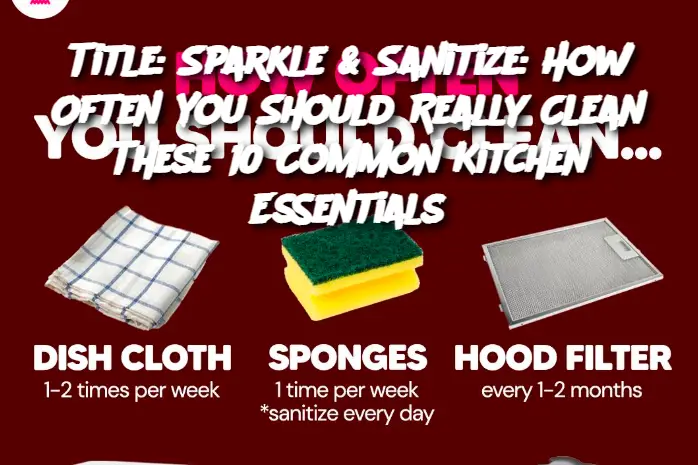🧽 How Often: Daily (or every few uses)
🧼 Why: Sponges are one of the dirtiest items in the kitchen, full of bacteria like E. coli.
✅ Tip: Disinfect daily by microwaving a damp sponge for 1 minute or tossing it in the dishwasher.
2. Cutting Boards
🔪 How Often: After each use
🧼 Why: Especially when used with raw meat, cutting boards can trap bacteria in grooves.
✅ Tip: Use separate boards for meat and produce, and scrub with hot soapy water or a vinegar solution.
3. Refrigerator Shelves
🥶 How Often: Monthly
🧼 Why: Spills, crumbs, and condensation can cause bacteria and odors.
✅ Tip: Wipe shelves with warm soapy water and a bit of baking soda to neutralize odors.
4. Coffee Maker
☕ How Often:
-
Daily: Rinse and dry removable parts
-
Monthly: Deep clean with vinegar cycle
🧼 Why: Mineral buildup and mold can affect taste and hygiene.
✅ Tip: Run one cycle of equal parts vinegar and water, then two cycles of plain water.
5. Microwave
📦 How Often: Weekly or as needed
🧼 Why: Food splatters and grease can build up fast.
✅ Tip: Steam clean by microwaving a bowl of water with lemon slices for 5 minutes, then wipe.
6. Oven
🔥 How Often: Every 3–6 months, or after messy spills
🧼 Why: Burnt food and grease buildup can cause smoke and odors.
✅ Tip: Use the self-cleaning function if available, or scrub with a baking soda paste and vinegar.
7. Stove Top (Gas or Electric)
🍳 How Often: After each use
🧼 Why: Spills harden quickly and can damage burners.
✅ Tip: Wipe with a damp cloth daily and deep clean weekly with degreaser or vinegar spray.
8. Blender or Food Processor
🥤 How Often: Immediately after use
🧼 Why: Dried food is harder to clean and can harbor bacteria.
✅ Tip: Blend warm water and a drop of dish soap for 30 seconds, then rinse.
9. Dish Rack
🧺 How Often: Weekly
🧼 Why: Constant moisture creates the perfect environment for mold and mildew.
✅ Tip: Wash with hot soapy water or run it through the dishwasher if it’s dishwasher-safe.
10. Kitchen Sink and Faucet
🚰 How Often:
-
Sink: Daily
-
Faucet/Aerator: Weekly
🧼 Why: Sinks carry more bacteria than toilet seats!
✅ Tip: Scrub with baking soda and vinegar or disinfectant, and sanitize faucet handles regularly.
Preparation:
No actual ingredients needed—just warm water, mild dish soap, vinegar, baking soda, lemon, and disinfectant spray can handle most cleaning jobs safely and effectively.
Serving and Storage Tips (Cleaning Edition):
-
Keep sponges and brushes dry between uses.
-
Store cutting boards upright to prevent moisture retention.
-
Line refrigerator drawers with washable mats for easy cleanup.
-
Always let appliances air dry fully before reassembling.
Variants (Extra Tools to Consider Cleaning Regularly):
-
Toaster Crumb Tray: Every 1–2 weeks
-
Drawer Pulls & Cabinet Handles: Weekly
-
Knife Block: Monthly (soak in vinegar water and dry thoroughly)
-
Trash Can Lid & Interior: Weekly
-
Reusable Grocery Bags: Monthly or after spills
FAQ:
Q: How do I know if my sponge needs to be replaced?
A: If it smells bad even after disinfecting, or starts to fall apart, toss it. Replace sponges every 1–2 weeks.
Q: Can I use bleach on kitchen surfaces?
A: Yes, but dilute it properly (1 tbsp bleach per 1 gallon of water) and rinse surfaces well afterward.
Q: Is vinegar safe for all appliances?
A: Avoid vinegar on natural stone or certain rubber seals—it can degrade them. Always check your appliance manual first.
Q: What’s better: dishcloth or sponge?
A: Dishcloths dry faster (less bacteria) and are reusable. Sponges are convenient but need more frequent disinfecting or replacement.
Q: How often should I deep clean the whole kitchen?
A: A full deep clean every 1–2 months helps reset everything and keeps the kitchen sanitary and organized.
